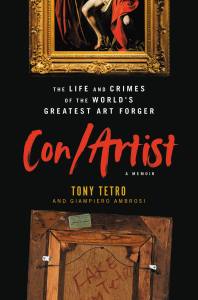Tony Tetro’s Fast Facts About the Secret World of Art Forgery
The world’s most renowned art forger reveals the secrets behind his decades of painting like the masters – exposing an art world that is far more corrupt than we ever knew while providing an art history wrapped in sex, drugs and Caravaggio. Read ahead for Tony Tetro’s 9 fast facts about the secret world of art forgery.
1.
Salvador Dali prepared tens of thousands of blank sheets of paper with his signature. Dealers could buy the paper and put what they wanted on it. It was a quick way for Dali to settle his debts.
As Tony says, “To me, that’s not even forgery, that’s just Dali not giving a shit.”
2.
Dali famously judged other artists on a scale of 1-10 on such categories as drawing, technique, composition, and color.
In his list of famous painters, Vermeer scored highest. Mondrian, lowest.
3.
Tony’s first forgery was a fake Chagall forgery by the famous con, Elmyr De Hory.
When Tony appeared at the gallery, the old-time actor Vincent Price, was coincidentally there. An art connoisseur, Price looked at Tony’s piece and succinctly canned it. “I don’t like him,” he said pointing at Elmyr’s name, “and I don’t like him,” pointing to Chagalls.
4.
As described in Con/Artist, Martin Scorsese’s work was highly influenced by Baroque Painter, Caravaggio.
In particular, Scorsese points to the bar scenes in his 1973 film, Mean Streets, saying “It’s basically people sitting in bars, people at tables, people getting up. The Calling of St Matthew, but in New York!
5.
Everybody in Tony’s circle of shady dealers and forgers called a fake, a Fugazi.
Despite some dubious etymologies, no one really knows why or where the word comes from.
6.
The great artist, Caravaggio, was a brawler, rogue, gambler and criminal. He was tried a dozen times for offenses such a libel, assault, and even murder.
His crimes caused him to flee Milan, Rome, and Malta and he died in Porto Ercole, Italy in 1610 under mysterious circumstances.
7.
If you send a Chagall painting to be evaluated by the Committee Chagall, they may end up legally destroying it.
The final arbiters of the authenticity of Marc Chagall’s work is the Committe Chagall, who under French law, claim the right to destroy any painting determined to be fake.
8.
Tony’s real name is now Antonia Montana Tetro – like the character Tony Montana from Scarface, the 1983 film starring Al Pacino
Tony changed his name legally in 2010 after friends celebrated his arrival in Costa Rica, “Hey Tony Montana’s in town.”
9.
The number of paintings sold for a particular artist can far exceed the number he or she really painted – sometimes vastly.
Rene Huyghe, the former Chief Curator of the Louvre Museum once joked, “Corot painted 3,000 canvases, 10,000 of which have been sold in America.”
The art world is a much dirtier, nastier business than you might expect. Tony Tetro, one of the most renowned art forgers in history, will make you question every masterpiece you’ve ever seen in a museum, gallery, or private collection. Tetro’s “Rembrandts,” “Caravaggios,” “Miros,” and hundreds of other works now hang on walls around the globe. In 2019, it was revealed that Prince Charles received into his collection a Picasso, Dali, Monet, and Chagall, insuring them for over 200 million pounds, only to later discover that they’re actually “Tetros.” And the kicker? In Tony’s words: “Even if some tycoon finds out his Rembrandt is a fake, what’s he going to do, turn it in? Now his Rembrandt just became motel art. Better to keep quiet and pass it on to the next guy. It’s the way things work for guys like me.” The Prince Charles scandal is the subject of a forthcoming feature documentary with Academy Award nominee Kief Davidson and coauthor Giampiero Ambrosi, in cooperation with Tetro.
Throughout Tetro’s career, his inimitable talent has been coupled with a reckless penchant for drugs, fast cars, and sleeping with other con artists. He was busted in 1989 and spent four years in court and one in prison. His voice—rough, wry, deeply authentic—is nothing like the high society he swanned around in, driving his Lamborghini or Ferrari, hobnobbing with aristocrats by day, and diving into debauchery when the lights went out. He’s a former furniture store clerk who can walk around in Caravaggio’s shoes, become Picasso or Monet, with an encyclopedic understanding of their paint, their canvases, their vision. For years, he hid it all in an unassuming California townhouse with a secret art room behind a full-length mirror. (Press #* on his phone and the mirror pops open.) Pairing up with coauthor Ambrosi, one of the investigative journalists who uncovered the 2019 scandal, Tetro unveils the art world in an epic, alluring, at times unbelievable, but all-true narrative.
